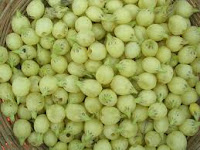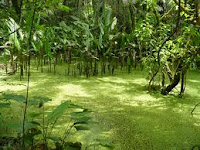The butter nut tree is an evergreen or semi-evergreen tree with a dense canopy, which grows in forests in the Indian subcontinent and Sri Lanka
 The “butter” from the butter nut tree comes from its oil-producing seeds, and this is used as an edible oil in some parts of
The “butter” from the butter nut tree comes from its oil-producing seeds, and this is used as an edible oil in some parts of The flowers are a yellow-white, which when ripe and fallen give place to an oval fruit which is initially green and then yellow when ripe. It ripens between May and September, depending on which part of the subcontinent the trees are in. The flesh is eaten as a vegetable, and the one to four seeds it contains can be pressed to obtain oil. Currently this is being studied for its potential as biodiesel. (Biomass and Bioenergy Vol. 35 (4) April 2011, pp.1539-44, Sangita Yadau et al. “Prospects and potential of Madhuca longifolia (Koenig) J f Macbride for nutritional and industrial purposes”. This concludes that as the seed oil contains palmitic, oleic, linoleic and stearic fatty acids it has both nutritional and industrial possibilities.)
 One study has shown that the ‘butter’ from these seeds has more free radical scavenging power than that of extra-virgin olive oil. There are studies underway which are investigating the cytotoxicity properties of the ethanol extract of the seeds and their oil.
One study has shown that the ‘butter’ from these seeds has more free radical scavenging power than that of extra-virgin olive oil. There are studies underway which are investigating the cytotoxicity properties of the ethanol extract of the seeds and their oil. Apart from the flowers the other aerial parts of this butter nut tree have medicinal properties and have been the subject of some clinical trials which have set out to determine if the traditional medicinal uses of this tree have any basis in scientific fact.
The powdered outer layer of bark is mixed with ghee and honey is used to enhance male libido, so is thought to be an aphrodisiac. The powdered bark is also mixed with long pepper and other ingredients to use as nasal drops for sinusitis and for epilepsy. The seed saponins have been found to have anti-inflammatory properties, and traditionally it has been massaged into joints to relieve the pain of rheumatism and arthritis. The bark is used in a variety of preparations to relieve itching, swellings, fractures, and for snake bites - externally. Internally it is used to treat diabetes mellitus.
 The heartwood of the tree has been used in traditional medicine systems for seizures. One study published in Pharmacognosy Communicatuions, 2011, Vol.1 (2) pp. 18-22 by Sandip Patel et al “Investigation into the mechanism of Action of Madhuca longifolia for its Anti-epileptic Activity” supported the traditional use of the heartwood in the treatment of epilepsy.
The heartwood of the tree has been used in traditional medicine systems for seizures. One study published in Pharmacognosy Communicatuions, 2011, Vol.1 (2) pp. 18-22 by Sandip Patel et al “Investigation into the mechanism of Action of Madhuca longifolia for its Anti-epileptic Activity” supported the traditional use of the heartwood in the treatment of epilepsy. The leaves are used for diabetes in Indian folk medicine and a study published in Internet Journal of Pharmacology 2009 Vol. 6 (2) by Rumi Ghosh et al “Antihyperglyaemic activity of Madhuca longifolia in alloxan-induced diabetic rats” showed that an ethanolic extract of the leaves demonstrated “significant hypoglycaemic activity” concluding that a long-term study was required to “develop potential antidiabetes drugs.”
 The leaves are said to have expectorant properties and so are used for coughs. They are also used in poultices and applied to eczema. They have been found to have antibacterial properties and are used as cooling agents in cases of fever.
The leaves are said to have expectorant properties and so are used for coughs. They are also used in poultices and applied to eczema. They have been found to have antibacterial properties and are used as cooling agents in cases of fever. This is another tree which has immense potential for human health.






























